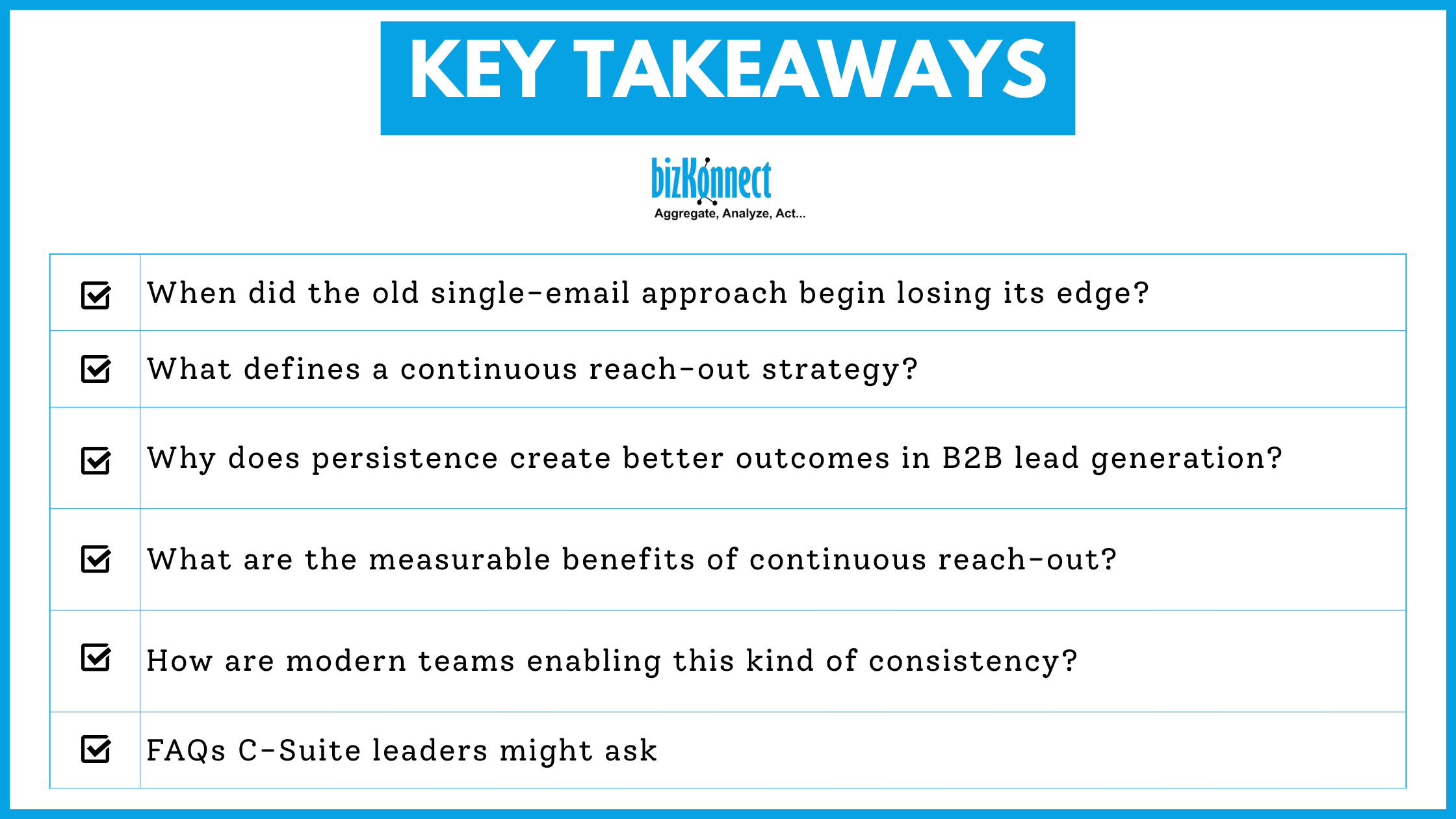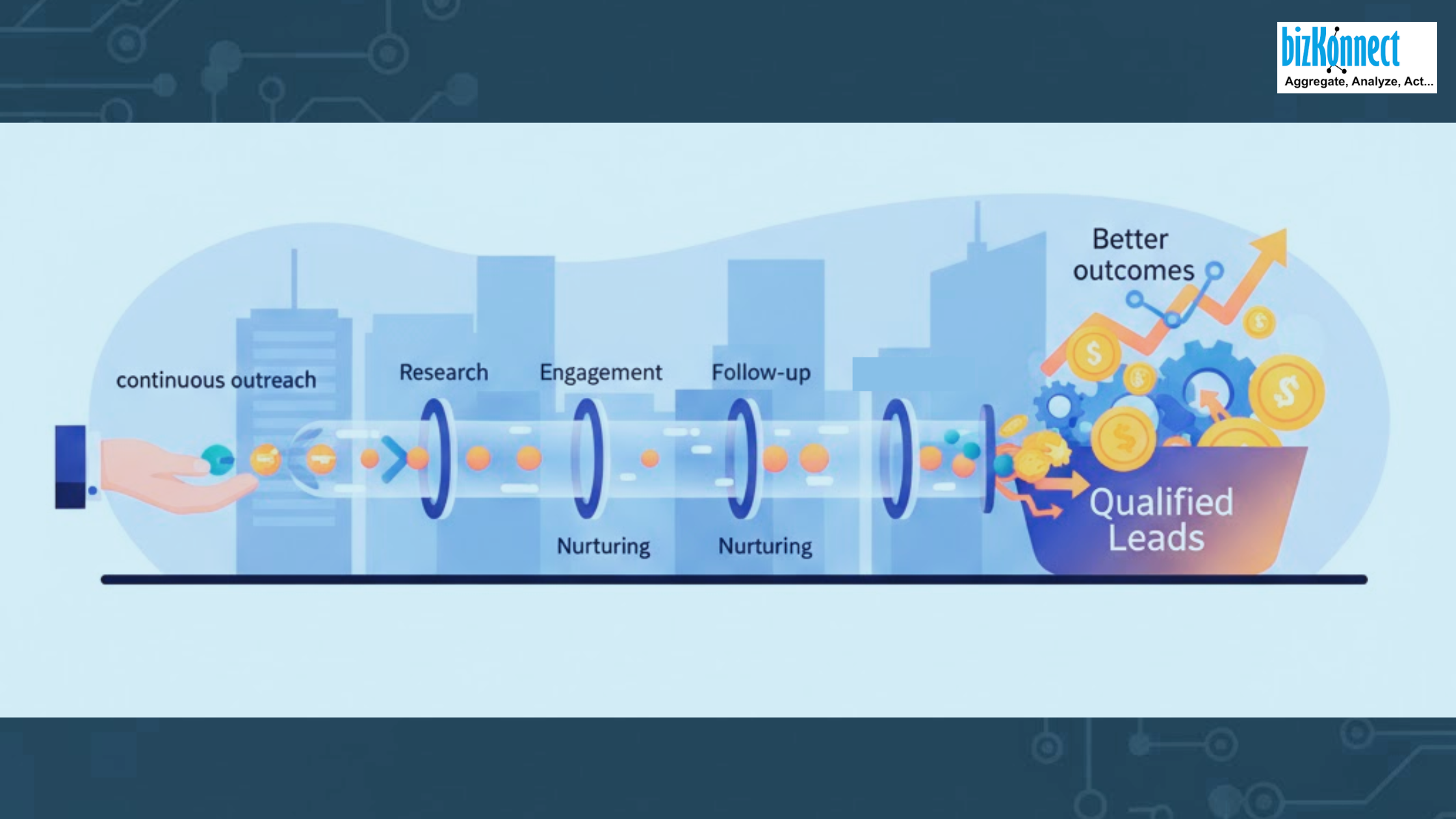In the early days of B2B email marketing, teams often followed a simple rule: send one email, then move on. The belief was that the first message mattered most, and non-responders weren’t interested. On paper, it looked efficient as thousands of emails were sent and open-rate charts were neatly tracked.
But most prospects ignored the email. Not because of disinterest; they simply weren’t ready for that offering. With long buying cycles and unpredictable timing, a single email rarely aligned with their moment of need.

Over time, responses dropped, pipelines slowed, and opportunities vanished because outreach stopped too soon.
This led to a new approach: continuous reach-out, built on consistency, patience, and value. B2B email marketing isn’t a one-off activity; it’s a steady process of engagement, relationship-building, and timing alignment. When prospects are ready, the brand is already part of the conversation.
When did the old single-email approach begin losing its edge?
The shift became clear as inboxes grew crowded and decision-makers became selective about what they engaged with. Sending one email and stopping afterward meant losing visibility almost instantly. Without follow-ups, there was no second chance to connect or clarify value.
Research supports this change in behavior. A recent study found that response rates can increase by over 220% after the first follow-up. Yet, many campaigns still stop after one attempt, leaving substantial opportunity untapped.
What defines a continuous reach-out strategy?
Continuous reach-out is more than sending multiple emails; it is a structured and purposeful engagement plan that spans the prospect’s journey. It begins with an initial outreach but extends far beyond, incorporating follow-ups, targeted insights, case studies, resource links, or industry updates delivered at intervals designed to remain relevant and useful.
Each message has a clear purpose: whether to educate, prompt reflection, or provide timely solutions, ensuring prospects see tangible value every time they interact. It avoids overwhelming recipients by maintaining a balanced cadence while preserving attention.
Modern continuous reach-out strategies also leverage performance data at every step. Metrics like open rates, clicks, replies, and unsubscribes inform adjustments to timing, subject lines, and content relevance. Here, GenAI-driven insights allow teams to identify the right prospect segments, anticipate organizational changes, and personalize outreach based on signals such as leadership updates, funding news, or strategic shifts.
The ultimate goal is twofold: consistency builds recognition, and recognition nurtures trust. Through a thoughtful, data-informed sequence, continuous outreach converts passive contacts into engaged prospects, steadily moving them toward meaningful conversations and eventual conversion.

Why does persistence create better outcomes in B2B lead generation?
A prospect’s readiness often fluctuates. Someone uninterested today might be in urgent need three months later. Continuous engagement increases the odds of reaching them when timing aligns.
It also reduces unnecessary churn in lead lists. Instead of constantly chasing new contacts, marketers nurture existing ones through relevant, value-driven interactions. That sustained presence builds brand recall and keeps the relationship alive.
According to a recent report, the average open rate for business emails across industries stands at 32.55%, and the most successful campaigns involve multiple touchpoints. A single email rarely captures this level of attention which a series often does.
What are the measurable benefits of continuous reach-out?
- Builds Visibility and Recall: Prospects may not act on the first message, but repetition when delivered thoughtfully, keeps the brand in sight and mind when they are ready to engage.
- Establishes Trust and Credibility: Regular communication signals reliability. When each email adds real value, the sender’s credibility strengthens over time.
- Catches Prospects at the Right Time: Buying intent evolves with organizational priorities. Consistent outreach increases the chances of meeting that moment naturally.
- Improves Engagement and Conversion Rates: Multiple touchpoints across email and LinkedIn create familiarity and guide prospects through awareness stages, improving conversions.
- Enables Data-Driven Optimization: Repeated outreach generates data such as open rates, clicks, responses that help refine future campaigns and personalize interactions.
- Reduces Wasted Effort and Cost: Nurturing the same qualified audience through different stages of awareness costs far less than acquiring new leads repeatedly.
- Supports Pipeline Predictability: A steady flow of outreach leads to a steady flow of responses and meetings, keeping the sales pipeline consistent.
How are modern teams enabling this kind of consistency?
Today’s marketers combine account-based strategies and actionable sales intelligence to understand prospects at a deeper level. With GenAI and data-driven insights, teams can map organizational changes such as leadership shifts, funding updates, or strategic priorities and tailor emails that feel timely and relevant.
These solutions don’t replace persistence; they strengthen it. Instead of sending more emails, teams send better ones which are crafted around genuine signals and precise timing.
In short, the modern B2B pipeline no longer thrives on one-time effort. Success now lies in the patience to nurture, the discipline to follow up, and the insight to engage at the right moment. Continuous reach-out ensures that when a buyer finally decides to act, the connection is already established and the conversation, already underway.
Some FAQs C-Suite leaders might ask
Q1. Does continuous outreach risk overwhelming prospects?
Not if managed with balance. The key lies in cadence, relevance, and personalization. Each message should offer new value, not repetition.
Q2. How often should follow-ups be sent?
For most B2B campaigns, 4–8 well-spaced emails over several weeks work effectively, followed by periodic re-engagement later.
Q3. Can this approach suit long sales cycles?
Yes. In fact, longer cycles benefit most because decision-making spans months, and consistent contact keeps your solution visible throughout.
Q4. How does continuous outreach support sales teams?
It delivers warmer leads with higher intent, reducing time wasted on cold prospects and improving the handoff between marketing and sales.
Curious how your next email campaign could outperform the last? Click here to start exploring with BizKonnect.